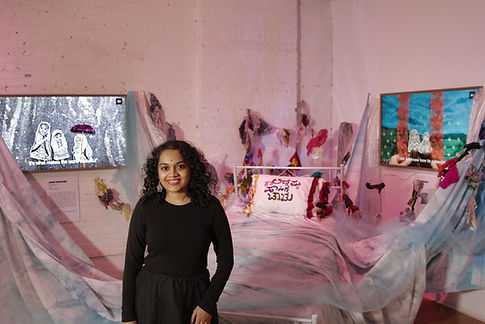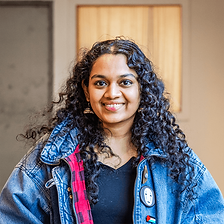Sultana’s Dream Popped Up
Pop-up books are a contradiction in themselves, quite like dreams. Just like dreams, which are present in our minds but not yet in our reality, the contents of a pop-up book indeed exist, but lie dormant until an action is taken towards their manifestation. This pop-up book spread is part of a series on Sultana’s Dream (1905), Begum Rokeya’s seminal work in feminist speculative fiction. My illustrated and paper-engineered version of the story aims to evoke the joy of childhood dreams, visions of possible worlds, and a reconnection with each little girl inside us. The fragility of paper is contrasted by bold lines and solid colours, representing the enormous strength even unassuming dreamers hold.
The Fascinating World of Pop-ups
In mid-June of 2024, during my art residency with Our Collective Practice, I had the serendipitous adventure into the world of—pop-up books! A throwback to childhood, if you may. My research question, “what would the world look like, if it was built on girls’ dreams for the future?”, had so much to unpack, not only in terms of content, but also, in form.
Here I had been, imagining a new world coming to life using sculptures and comics, being blind to exploring mediums I had little to no knowledge about, which felt off, given the surreal, otherworldly nature of my project. So I signed up for an introductory paper engineering (a fancy way to say pop-up bookmaking!) workshop, with no expectations.
SAFE TO SAY, THAT WORKSHOP CHANGED THE COURSE OF MY ARTMAKING.




I thought deeply about why pop-up books make me feel so different about the way I was approaching art— in a way that no other exhibit had made me feel.
To be more specific, why did I feel so drawn to using pop-ups (along with other art forms) in the immersive world I was concocting? Was it the playful nature of the medium? Its accessibility? The nostalgic feeling of childhood, of being a little girl again perhaps it was all of those. I couldn’t put my finger on it.
The more I thought about it, the more I realised it was far more important to disconnect from exactly that — thinking. I had to remove myself from the cage of being “serious” or an “artist”, and just be a child. Just play. I had to make pop-up books and ask myself how I felt about my project. This residency offered me the perfect conditions for my exploration, without demanding a white cube result.
So there I was, reading Sultana’s Dream, and playing with scraps of paper, cutting odd shapes, and watching “How To Make Your First Pop-Up” videos on YouTube one day, and ordering protractors, rulers, and cutting boards the next. It was weeks and weeks of trial and error, finding the right kind of glue, stressing out at first and then laughing about how a tiny fold can really make or break your final design.
It felt liberating. It felt fun. It felt—like girlhood should.


The process started revealing answers to my initial nudge of curiosity — why did I feel so drawn to use this for my project?
The act of opening a pop-up is perhaps where the reason lies. The moment when you aren’t sure what to expect, where you can sense movement but uncertain about where it will lead, the feeling of a tiny drop of adventure when a piece of paper becomes magic, where there is change. And isn’t that what imagination and dreaming is like? Like how between the folds of a pop-up, lies dormant magic. And how that magic can be activated by a small act of opening a page, aren’t all big dreams that lie dormant in ourselves get activated by tiny steps toward action?
Like pop-ups, dreams are worlds that both exist and do not. It is up to us whether we take the small yet vital step of letting our curiosity get the better of us.




Dreams pop out into the world
On 25 September 2024, I had the amazing opportunity to present these pop up books at the Blue Gallery, NYC, thanks to the wonderful team at Our Collective Practice. It was particularly special as the exhibit was a part of a gathering by prominent feminist organizations: Noor, Just Futures Collaborative, and the Urgent Action Fund.
It was so lovely to see people interact with each other while opening the pop-ups. You could really feel the childlike joy return to them during the tiny moment of surprise. I had put in a lot of thought into how I used this form as a means to bring out our inner child, and this validated that artistic decision more than ever.
Reclaiming our right to dream and reimagine the world is a deeply political act—a fundamental step toward creating worlds where everyone belongs and feels safe.
Girls and young feminists have always reminded us of this truth and continue to do so. Anchoring our collective feminist imagination in a feminist who continues to inspire us despite being a century apart, this exhibit honors past, present, and future girls and young feminists, inspiring us to reclaim and use our dreams as tools for our collective liberation.
This exhibit was part of my artistic exploration during my residency with Our Collective Practice, and a summer research grant from my university, NYU Gallatin. While eventually, my art residency took another direction filled with games, fabric collage, films, and installation, the time and space that this residency offered is a testament to the importance of longer paths, redirection, and successes found in the haziness of experimentation.
FOREVER GRATEFUL!

.jpeg)

“Si se apoyaran los sueños de las niñas y jóvenes feministas, el mundo sería un lugar más amable y pacífico, con menos guerras o ninguna, un lugar donde ninguna persona moriría de hambre y ni viviría en la calle. Tal vez sea una ilusión, tal vez el patriarcado aún se las arreglaría de algún modo para manifestarse en este mundo, pero creo que tendríamos más herramientas, recursos y educación emocional para hacerle frente.”
Carolina Vozian es escritora, trabajadora cultural, facilitadora, feminista y activista cuir(queer). Imparte talleres de escritura creativa, organiza actos culturales y políticos y ha publicado su primera novela y otros textos en volúmenes colectivos. Junto con Andy Andreea, es comisaria de la plataforma de arte especulativo radical lumiposibile.ro. Le gusta sentarse junto a las olas, los ríos, los abetos y los sauces. Nació y creció en la República de Moldavia y actualmente vive en Bucarest (Rumanía) con sus gatos.



.jpg)


